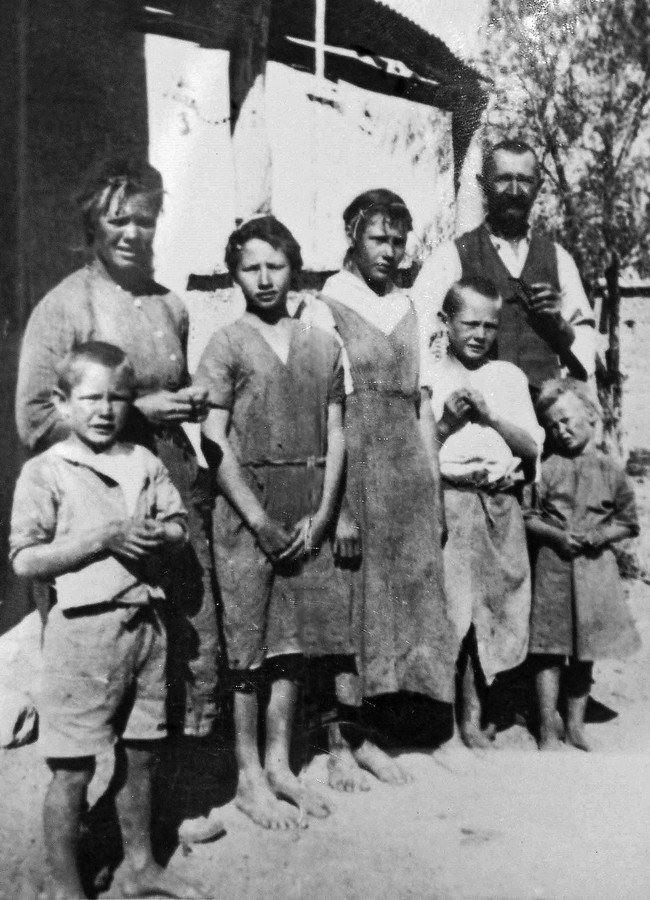
Namibia: Etnicity

Figure 1.--This is the Lemcke family, Albert and Carolina Lemcke with some of their nine children. The Lemckes were a Afrikaner farmer family (Boers). The photograph was taken in early-1910s just before World war I in the Omaheke region. At the time, Namibia was at the time a German colony.
|
|
Namibia has a diverse ethnic structure. The principal Aftrican group is the are the Ovambo. Other tribes include: Caprivian (Lozi), Damara, Herero/Himba, Kavango, Nama, San, and Tswana. Mixed race groups include: Coloured and Rehoboth Baster. White Namibians include Afrikaner, German, British and Portuguese). The mixed race people are a little complicated. Coloured sems to mean means mixed African/White ancestry. Rehoboth Baster sems to means mixed race peole (African/Afrikanner) ancestry. There is relatively little mixing among the different groups in Namibia.
The Coloureds and Basters share similar ancestries and cultural attributes (such as language), but nonetheless maintain largely separate communal identities, as do most white Namibians and African Namibians. The Ovambo are the dominant African group and are riughly half of Namibia's population. The Ovambo, Kavango, and East Caprivian historically inhabited the relatively well-watered and wooded northern area of Namibia. They maintain traditional settled farming and herding lifestyle. They have exhibited minimal interest in the harsh, arid central and southern parts of Namibia which offered little posibility of agiculture. The population was as a resulted mostly located in the north. Before the arrival of Europeans, these tribes had little contact with the Nama, Damara, and Herero to the south. These tribes settled in the central region of Namibia struggled for control of the limited,sparse pastureland. Warfare was thus endmic. The Europeans showed little interest in what is now Namibia, except for Walfis Bay. Thus the area was up for grabs when the newly unifoed German enteed the Scranble for Africa. German colonial rule was brutal. Large numbers of the Herero perished in the Herero Wars. The Germans did end the fighting. The Germans or South Africans after World War II did not, however, attempt to change identities and traditional organization. Thee have been demographic chnges since indeoendence. People from the noerhern tribs have now settled throughout the country as aesult of urbanization, industrialization, and employment opportunities. The mining, farming, and industrial sectors continues to be contolled by the white minority. Thee sectorshave had an impacr on traditional African society without completely transforming it. Urban as well as migratory workers have largely adopted Western life styles. People living in rural areas continue to live traditional lfe styles. The various Africans speak various indigenous languages. The white population is largely of Afrikaaner discent. There are also people of British, and German descent, with a few Portuguese. Some 60 percent of Namibia whites speak Afrikaans (a language derived from the 17th century Dutch settlers). Another 30 percent speak German. Some 5 percent speak English.
A Dutch reader wites, "Some years ago I went to South Africa and Namibia, two countries where I recognized many familiar cultural aspects for somebody who grew up in the Netherlands. Although I could understand most of what was being said, I had more trouble with the spoken word (Afrikaans). There were so many languages, all different. The printed Afrikaans word was no problem, but the spoken lnguage was much mire difficult. You mention some of the many tribes, also the Caprivians. Those people live in the Caprivi Strip in the northeast corner of Namibia. The "Strip" is named after Count Georg von Caprivi Caprera und Montecuccoli, who was the Imperial German Chancellor that relaced Bimarck when Kaiser Wilhelm II eased him out (18900. Namibia at the time was German Southwest Africa." Caprivi gained The Strip named after him, but at the Kaiser's urging allowed the Reinsurance Treaty with Tsarist Russia to lapse. This would prove to a major reason that Germany lost World War I.
HBC

Navigate the Boys' Historical Clothing Web Site:
[Introduction]
[Activities]
[Biographies]
[Chronology]
[Cloth and textiles]
[Clothing styles]
[Countries]
[Topics]
[Bibliographies]
[Contributions]
[FAQs]
[Glossaries]
[Images]
[Links]
[Registration]
[Tools]
[Boys' Clothing Home]
Navigate the Boys' Historical Clothing national pages:
[Return to the Main Namibian page]
[Return to the Main African country page]
[Return to the Main African page]
[Algeria]
[Angola]
[Botswana]
[Burkina Faso]
[Congo]
[Ethiopia]
[Gabon]
[Ivory Coast]
[Kenya]
[Lesotho]
[Mali]
[Somalia]
[South Africa]
[Uganda]
[Zambia]
[Zimbanwe]
Created: 8:03 AM 1/17/2016
Last updated: 8:03 AM 1/17/2016



